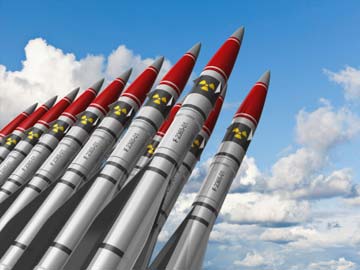by William M Arkin and Prof Michel Chossudovsky, Global Research:

This incisive article by William Arkin summarizes the key elements of America’s nuclear doctrine, formulated both before and in the immediate wake of September 11, 2001.
The article was originally published by the Los Angeles Times on March 10, 2002, a few months prior to the official release of the infamous 2001 Nuclear Posture Review (NPR).
The doctrine of mutually assured destruction (MAD) of the Cold War era has been indefinitely scrapped.
The NPR 2001 confirms America’s foreign policy stance:
the pre-emptive use of nukes as a means of “self-defense” against both nuclear and non-nuclear states.
TRUTH LIVES on at https://sgtreport.tv/
Nuclear weapons are also slated to be used in the conventional war theater.
Post Cold War Nuclear Doctrine. NPR 2001 (Drafted 23 Years Ago) Sets The Stage
Let us be under no illusions.
Today, nuclear war is on the drawing board of the Pentagon.
The 2001 NPR (full document) released (officially) in July 2002 is of utmost significance. It determines America’s nuclear doctrine. It has a direct bearing on our understanding of the war in Ukraine, and the danger of a World War III scenario. For details, see also NPR 2001 (excerpts by FAS).
The geopolitics of America’s nuclear doctrine (NPR 2001) are outlined: Russia and the “Axis of Evil”, China and the status of Taiwan, Israel, Iran and the Middle East, North Korea.
The modalities consist in integrating a new category of nuclear weapons (allegedly safe for the surrounding civilian population) into the conventional war arsenal.
Minimizing Collateral Damage while “Blowing up the Planet”
Here are some of the highlights outlined in William Arkin’s article, most of which are being implemented:
- “...the use of nuclear weapons against at least seven countries … naming not only Russia and the “axis of evil”–Iraq, Iran, and North Korea–but also China, Libya and Syria.”
- “nuclear weapons may be required in some future Arab-Israeli crisis.”
- “…using nuclear weapons to retaliate against chemical or biological attacks”
- “the NPR lists a military confrontation over the status of Taiwan as one of the scenarios that could lead Washington to use nuclear weapons.”
- “nuclear strategy …viewed through the prism of Sept. 11. faith in old-fashioned deterrence is gone”
- “developing such things as nuclear bunker-busters and surgical “warheads that reduce collateral damage,”
- “cyber-warfare and other nonnuclear military capabilities would be integrated into nuclear-strike forces”
- “the integration of “new nonnuclear strategic capabilities” into nuclear-war plans.
- “expand the breadth and flexibility of U.S. nuclear capabilities.
- “what has evolved since last year’s [September 11, 2001] terror attacks is an integrated, significantly expanded planning doctrine for nuclear wars.”
Michel Chossudovsky, Global Research, September 10, 2022, August 4, 2024
***
Secret Plan Outlines the Unthinkable
The Bush administration, in a secret policy review completed early this year, has ordered the Pentagon to draft contingency plans for the use of nuclear weapons against at least seven countries, naming not only Russia and the “axis of evil”–Iraq, Iran, and North Korea–but also China, Libya and Syria.
In addition, the U.S. Defense Department has been told to prepare for the possibility that nuclear weapons may be required in some future Arab-Israeli crisis. And, it is to develop plans for using nuclear weapons to retaliate against chemical or biological attacks, as well as “surprising military developments” of an unspecified nature.
These and a host of other directives, including calls for developing bunker-busting mini-nukes and nuclear weapons that reduce collateral damage, are contained in a still-classified document called the Nuclear Posture Review (NPR), which was delivered to Congress on Jan. 8.
Like all such documents since the dawning of the Atomic Age more than a half-century ago, this NPR offers a chilling glimpse into the world of nuclear-war planners: With a Strangelovian genius, they cover every conceivable circumstance in which a president might wish to use nuclear weapons–planning in great detail for a war they hope never to wage.
In this top-secret domain, there has always been an inconsistency between America’s diplomatic objectives of reducing nuclear arsenals and preventing the proliferation of weapons of mass destruction, on the one hand, and the military imperative to prepare for the unthinkable, on the other.
Nevertheless, the Bush administration plan reverses an almost two-decade-long trend of relegating nuclear weapons to the category of weapons of last resort. It also redefines nuclear requirements in hurried post-Sept. 11 terms.
In these and other ways, the still-secret document offers insights into the evolving views of nuclear strategists in Secretary Donald H. Rumsfeld’s Defense Department.
While downgrading the threat from Russia and publicly emphasizing their commitment to reducing the number of long-range nuclear weapons, Defense Department strategists promote tactical and so-called “adaptive” nuclear capabilities to deal with contingencies where large nuclear arsenals are not demanded.
They seek a host of new weapons and support systems, including conventional military and cyber warfare capabilities integrated with nuclear warfare. The end product is a now-familiar post-Afghanistan model–with nuclear capability added. It combines precision weapons, long-range strikes, and special and covert operations.



